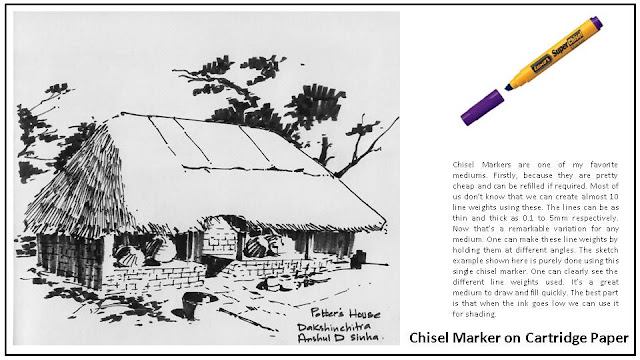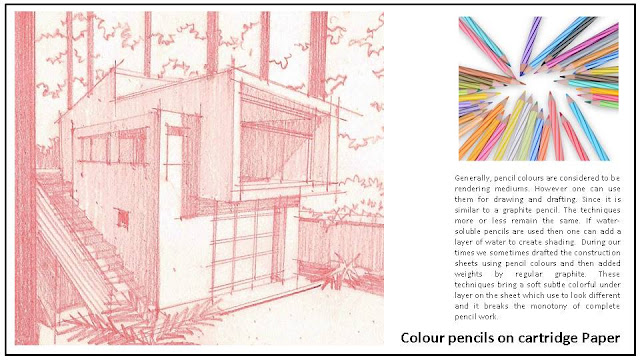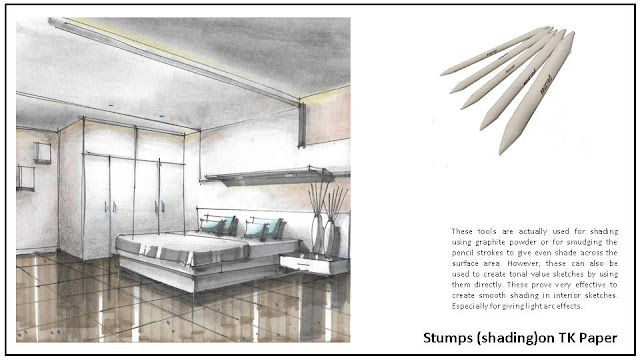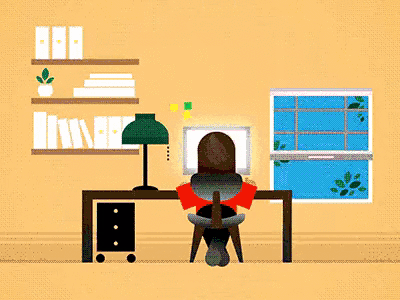Mediums for Architectural Sketching
Introduction
While starting architectural sketching, students often ask! Which is the best medium to use? My answer to them is "Every medium is good, maybe we need to learn methods to use them effectively.’ Architectural sketching has an endless possibility. We can use simple to highly advanced digital tools to create visualizations. Each medium gives a different experience of use and presentation. Some mediums appear difficult and others easy. Some give informal looks and others formal ones. Some look professional and others amateur. Some are time-consuming, whereas others may be very quick. In order to draw effectively. One must know which tool to choose under a particular situation or for a particular building design. Even the sketcher’s mood and time in hand affects the choice of medium.
In this blog I have compiled the various mediums and tools that can be used at will to sketch. Using different medium helps one to gather varied effects, Styles and experiences.
I hope this blog will help you to know more about the mediums and will release a few myths about tools.
A regular wooden pencil is one of the most versatile media of all. One can create variations in line weights and shades by controlling the hand pressures. Pencil can be held at different angles to create multiple shading textures. Pencils work differently on papers. Use a sharp tip to draw lines and a chiseled tip for shading in different styles.
Flat lead pencils are very useful in drawing sketches that need rapid shading and filling. The flat lead due to its thickness provides faster coverage. We can chisel it and use it for various line thicknesses. One can quickly shift the line weights by rotating it in different directions.
 (For any details contact us)
(For any details contact us)
Website: www.tsapmumbai.in
E-mail: tsap@thakureducation.org
Contact: 022-67308001/02
Whatsapp: +91-9833665446
Mechanical pencils prove equally effective while sketching. Firstly, it releases the pressure of getting line weight variations. I recommend using a 2B grade Rotring leads as they are super smooth and soft. It's sheer pleasure using the lead. Mechanical pencils are available in 0.35, 0.5, 0.7, 0.9, 1.2 mm thickness. I personally feel the 0.7 has a lot more possibilities of using it for drawing and shading . Use mechanical pencils with steel tip end. It helps to gain precision and lasts longer.
These are brilliant and the cheapest fine liner pens available in the market. Firstly, one must know that these are water-based ink pens, hence not waterproof. This understanding can help us make sketches that are purely in ink, and we can also use a bit of water to create a smudging and blotting effect.
`
Staedtler pigment liners are waterproof and offer great control when it comes to sketching in pen. The ink consistency is stable and vibrant. Different degree of angular grip creates multiple line weights and tonal gradation. One can lightly sketch using thin lines with an angle of about 20-30 degrees. One must not put heavy pressure on these pens while using. Although the nib is stronger than other fine liners, it is vulnerable to split open resulting in damage. Since it's a waterproof ink, it's convenient to use any wet medium post inking. The lines will never blot if the sketch is drawn with minimal erasing. It's a good medium to use on paper, tracings and gateway.
Isograph pens are the most reliable mediums to use when it comes to having consistency in line weights while drawing. These pens come in various thicknesses. These pens work with waterproof inks and hence are very good to do line and wash sketches. We can sketch as well as write using this medium. It's a pleasure to use these pens. Initially, it feels that the needle-like nib will break while sketching; however, with minimal pressure, one can draw very efficiently. For sketching, the 0.3 mm nib is a good option as it is hard and of medium line weight. Isographs are economical to use as it is refillable and if used with care can last for years.
Sign pens are very effective to use for sketching quickly with bold lines. These come with a durable nib than compared to sketch pens, hence can be used for adding line weights to the sketches or for filling. These are cheaper mediums of use. One can also use them to draw structures with a lot of intricate detailing. These intricate detailing can be simplified into masses to reduce the efforts and drawing scope.
Fountain Pens happen to be the pride of the Architect’s pockets. Ink pens come with different weights: Fine, Superfine, Medium, and Heavy. Each thickness helps to get variations in line weights. One can flip the nib and use the other side to draw thin lines. It simply means that you have at least two line weights from the same nib. We can use different colours of ink and draw. Fountain pens are reusable, hence very sustainable.
Chisel Markers are one of my favorite mediums. Firstly, because they are pretty cheap and can be refilled if required. Most of us don’t know that we can create almost 10 line weights using these. The lines can be as thin and thick as 0.1 to 5mm respectively. Now that’s a remarkable variation for any medium. One can make these line weights by holding them at different angles. The sketch example shown here is purely done using this single chisel marker. One can clearly see the different line weights used. It’s a great medium to draw and fill quickly. The best part is that when the ink goes low we can use it for shading.
As Architecture student or practitioner we generally rely on a graphic pen and fine liners for drawing. However, a ball pen can also be used effectively. Different hand pressures produce wide-ranging stroke quality. One can make a faint line by just gliding the pen over the paper surface. On the other hand, a dark line can be drawn using heavy pressure. One can also notice the difference in line thickness if the pen is held at a very low angle to the paper. The tonal gradations in the pen can be created by cross-hatching methods or by controlling the density of line work.
Digital sketch pads and pens offer a new dimension in sketching. This medium if practiced can open a huge range of possible outcomes. Working with digital mediums on software like Photoshop, Autodesk Sketchbook, Art Rage, etc. is simply fun. There are numerous tools, effects, and textures that can be easily applied and convert your rough sketches into highly realistic and sometimes dreamy visualizations. Using a digital pen sometimes is tricky as you have to draw looking at the screen. It takes a while to get use to getting mind and hand coordination.
Most of us have Smart Phones, but do we use them smartly? Memo Pads and other sketching Apps can be very handy to sketch out ideas and concepts during travel or on-site meetings. You may carry a stylus to be able to draw effectively and precisely on the apps. You can get architectural strokes and many modes of rendering.
There are many sketchers around the globe who use waterproof ink with a brush or twigs to draw. Waterproof ink has a thicker consistency and dries quickly. It’s a beautiful medium to use when it comes to using ink Dip methods. One has to periodically dip the brush or tools and draw. When used with a brush it opens up a possibility of harsh scrubbing on papers that creates smudged rough trees and shade. You may also drop ink and blow it to create a spot effect.
This is one more unusual medium that can be used for sketching. Glass dip pens are actually used for ages for scripting. The experience of using glass is very fascinating. It's interesting to see how long the pen can work after a single dip. I found that we can have all the possible line types using this pen. Although the possibility of achieving line weights is limited, the overall user experience is different.
I feel working with white mediums on dark papers brings a profound learning experience. One starts observing the shades and shadows very carefully as we need to leave those portions as paper colour. This medium brings a deeper understanding of tonal value. Many times students using white ink miss to understand that the impact of sciography or realism would only come when they leave the shadows in paper colour. These mediums can be used for conceptual development. One can learn the negative and positive aspects of drawing using this medium.
Generally, pencil colours are considered to be rendering mediums. However one can use them for drawing and drafting. Since it is similar to a graphite pencil. The techniques more or less remain the same. If water-soluble pencils are used then one can add a layer of water to create shading. During our times we sometimes drafted the construction sheets using pencil colours and then added weights by regular graphite. These techniques bring a soft subtle colorful under layer on the sheet which use to look different and it breaks the monotony of complete pencil work.
Alcohol-Based ink markers are the trending ones in the market. These mediums give an instant professional look to the sketch. There are hundreds of shades available. These markers can be used to create a very graphical drawing to highly realistic sketches using meticulous layering and tonal value. These pens show different spreads when used rapidly and with constant slow speed. The ink bleeds onto the normal papers. In architectural sketching, one can choose to use a very limited palette to make an effective sketch.
Alcohol-Based ink markers can be used to draw and render the sketches. You can use light grey markers to sketch and then render as per the colour scheme. Markers come with chisel and brush head tip on either side. I generally recommend using the chisel tip for better control and varied line types. Always create a shade card of the colours you have, which helps in reducing errors of choosing the wrong shade while rendering.
Bamboo pens are traditional writing instruments that can also be used for sketching. These pens come in different sizes of Nibs. It takes a while to get control of this medium. One needs to practice understanding the various line weights and shade possibilities by holding them in different angles. Once held very low, one is able to apply surface shading too.
Brush pens, as the name suggests, offer the mixed experience of a pen and flexibility of agility of a brush. Since the tip is soft, the slightest pressure difference creates a difference in line weights. This can be an advantage or a challenge in using this medium.
Many years ago sketch pen renderings were in trend in the absence of economical markers. The sketch pens come very handy to do stroke rendering. We can render using repeated horizontal, vertical, and angular strokes.
This is an unusual medium. One can sketch using an empty refill too. We can sketch on the paper to create embossed line work and then a layer of shading can be given using graphite lead or regular chiseled pencil. I recommend adding the tonal value differences while shading to achieve realism and 3Diness.
The feather has always been used to write in the olden days. In recent times it's rare to find such pens and writers. Sometimes using unusual mediums helps us innovate or find new ways to use such tools. I believe that nothing should stop us from sketching if we have the will. This sketch is drawn using an Owl feather using the dip in ink technique. The feather cannot hold much ink hence we need to dip it in ink and use it. A 5 minute practice on rough paper helps one to know stroke qualities using different angles and rotations. It gives great power once we complete something in an unusual technique.
These tools are actually used for shading using graphite powder or for smudging the pencil strokes to give even shade across the surface area. However, these can also be used to create tonal value sketches by using them directly. These prove very effective to create smooth shading in interior sketches. Especially for giving light arc effects.
These pens are generally used for some art assignments but can be used at times to sketch buildings. These pens have highly fluid shimmering ink that gives a unique look to the drawing. Extremely fluid ink leads to slippery strokes while drawing. One must clean the nib tip frequently to avoid big ink spots at the start of the strokes.
These gel pens are also an interesting medium. They can be used to do line sketches. Many a time these are used to add highlights in some parts of the drawing, such as sheen, glass hatching, glazing lines, textures and gloss reflections etc. They work best on dark non-absorbent papers.
This medium is rarely used for sketching or shading but one can attempt a few sketches. This is essentially used for marking on the glass. The lead contains wax and hence gives a feeling of drawing with a crayon. This can also be used as a cheaper alternative to the expensive white charcoal pencils. Although I am suggesting this as an alternative, one should not expect to have the same amount of vibrancy as Charcoal.
These pens can be very handy and economical alternative. Gel inks are waterproof and have jet black colour saturation hence can be used for line and wash sketches. One can add different line weights using angular grips. One must note that since the ink consistency is highly fluid, the pen slips while sketching which affects the line quality and control.
Bold markers have a round tip and a sturdy nib. The nib profile offers a better control to draw and fill patches with precision. It's a simpler medium to handle and requires little skills. One can choose to sketch using these markers in a monochrome or colorful mode. We can achieve limited line weights with this medium.
OHP markers or CD markers as we commonly call them can also be used for sketching times. One of the characters of these pens is that it leaves a blot on paper the moment it comes in contact. This character helps to get architectural strokes easily. The ink tone may show some sheen with crimson or magenta colour, which at times is disturbing to the eyes. OHP markers will show considerable bloating on cartridge paper than TK or ivory sheets.
Plastic erasable crayons can also be used to create rough-textured sketches. Instead of using the tip break the crayon into pieces and then use them flat on paper to create more coverage with minimal strokes. This technique also adds texture like charcoal strokes. We may also layer the sketch using Watercolour.
Happy Sketching!!!!!!
Assistant professor





































Sir your collections with different techniques and mediums are just mind blowing !!!! 🙏
ReplyDeleteThat's a wide range of variety, every architecture student should know about this mediums. Really helpful💯
ReplyDeleteExcellent in-depth article
ReplyDeleteFound it difficult to stop looking at all the Drawings sir ! Amazing and interesting techniques of Drawing
ReplyDeleteThe blog had widened the range of materials and mediums for my sketching. The information and techniques are really helpful thank you for sharing your knowledge with us. 🙏🏻
ReplyDeleteSir this techniques and mediums actually give us the idea to go explore each medium and your work is mind-blowing
ReplyDeleteExtremely extraordinary work love the manner in which u gave the picture of the apparatuses utilized in very portrays... This blog offers inspiration to restart the handdone sketches rather thn computerized/ digital ones keep going and sharing your work sir.
ReplyDeleteAmazing sketches with such varied mediums. This blog broadens the scope in terms of various medium and also encourages to try them.
ReplyDeleteThese variety of sketching techniques and the explanation of how to properly use them the method of holding the sketching tool.. the stroke intensity knowledge.. the different shading methods...the exploration of vivid mediums...the order of the sketching tools from basic to digital.....this blog has said it all...🙌 Hats off sir for spreading this knowledge...this is a blog which every student belonging to the art and architecture field must know...its almost like the years you have spend for the exploration of these techniques you have just made it easy for us to understand it through this wonderful blog...its very rare to find such teachers who share their each and every knowledge in detail..we are fortunate to have your knowledge....beautiful blog.😍
ReplyDeleteThank you for the informative blog sir!Will definitely try out these various mediums! :)
ReplyDeleteWhat an amazing set of drawings sir.
ReplyDeleteIt's always so great to read through your blogs and gain the knowledge you share.
Amazing blog...really helpful for further renderings... Thank you for sharing.
ReplyDeleteAmazing Article!!! The different ways of sketching techniques are very nicely explained.
ReplyDeleteThis is the most amazing compilation, I have ever come across. The exhaustive ✨✨✨ compilation touches upon the potential of each medium for its eloquent reach.
ReplyDeleteInspired to explore...👌👍✨✨
Inspiring & very helpful blog Sir!!
ReplyDeleteThankyou for sharing.